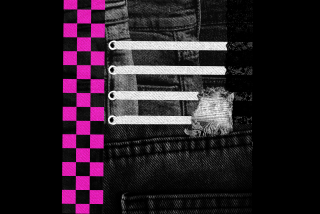Too Close to Dirty for the Dance
The grainy high school dance video is lurid.
A teenage boy dances behind his winter-formal date, hands on her hips, thrusting his pelvis against her while she hitches up her satiny gown and bends at the waist. Another couple dance facing each other, their bodies enmeshed and their hips gyrating in a frenzy. A boy approaches a third couple, nearly sandwiching the girl between himself and her partner.
Teenagers call it “freaking,” a style of dance made popular on MTV. Educators call it “simulated sex” that has no place at school dances. This clash between outraged adults and sexualized teens is being played out at homecoming dances, winter formals and proms across the nation, most recently at Aliso Niguel High School in Aliso Viejo.
After a jungle-themed dance in September, Principal Charles Salter canceled all future dances until students, parents and administrators craft a plan to stop freak dancing.
For months he’d implored parents to get their children to stop freaking, and even showed a video of the school dance to hundreds of parents at back-to-school night.
“The ‘dancing’ of our youngsters today is one step from events that should be occurring on wedding nights,” he wrote in an e-mail to parents.
Though forms of freak dancing -- also called “grinding” or “the nasty” -- first appeared years ago, so many students are doing it now that educators nationwide are drawing up rules of behavior, changing music formats away from freak-friendly hip-hop, and banning from dances students whose movements are deemed too sexual.
“Of all the things that happen at a high school, having to spend so much time on dances -- that’s out of whack,” said Kelly Godfrey, principal of Los Alamitos High School in Orange County.
Some students say a crackdown on freaking would discourage them from attending school dances.
“I wouldn’t go,” said Chelsea Walsh, 15, a sophomore at Aliso Niguel High. “It would be boring. How else do you dance?”
*
When the waltz was first performed at a royal British ball in 1816, the Times of London wrote: “So long as this obscene display was confined to prostitutes and adulteresses, we did not think it deserving of notice; but now that it is attempted to be forced on the respectable classes of society ... we feel it a duty to warn every parent against exposing his daughter to so fatal a contagion.”
Similar generational clashes over the tango, the twist and Elvis Presley’s gyrating hips followed; the theme was celebrated in the 1984 movie “Footloose.”
Freaking has gained widespread acceptance in recent years, propelled by the mainstreaming of rap music and the sultry images in hip-hop videos. Critics say its unquestionably carnal positions -- girl bent at the waist, boy thrusting behind her -- go far beyond previous generations’ bumping and grinding.
“Every generation finds its successors’ dances to be improprieties,” said Judith Lynne Hanna, a University of Maryland senior scholar and author of a book on dance and sexuality.
“What is the difference between frontal body rubbing and one person rubbing a backside against a front side?” she asked. “It’s all sexy. Dancing is sexy. But so what? It’s not sex. It’s flirtation.”
Whatever it is, educators from New Hampshire to Washington state are growing increasingly agitated.
Shana Kemp, spokeswoman for the National Assn. of Secondary School Principals in Reston, Va., said the organization had received an unusually high number of calls in recent months about freak dancing.
“Each generation has its own thing that ... adults think is inappropriate. It’s just par for the course for the changing of the times,” she said. “But in some instances, it’s taken too far.”
Just this month, Principal Patricia Law canceled all school dances at Windsor High School north of Santa Rosa for the rest of the year after a homecoming dance where three-quarters of the nearly 800 students in attendance were freak dancing. She said students can win back their dances if they come up with a plan to keep their moves clean.
“It was time for a wake-up call,” Law said.
At Wethersfield High School outside of Hartford, Conn., Principal Thomas Moore said he’d grown increasingly concerned as more students started freak dancing. Last year, he estimated, three-quarters of the student body were freaking.
Student council members launched their own campaign, “Freeze the Freak,” visiting social-studies classes where they led student-only discussions about the issue.
Moore also regularly turns on the lights during dances and changed the music format at September’s back-to-school dance.
“We went with a lot of wedding music, like the ‘Macarena’ and the ‘Electric Slide,’ to get away from some of the real bass-thumping club music,” he said. “A lot of kids had fun with it. A lot of kids left.”
Several California schools have adopted detailed dance policies and kick out students who repeatedly cross the line.
This year, Montgomery High School students in Santa Rosa received this notice: “Dancing styles that involve intimate touching of the breasts, buttocks or genitals or that simulate sexual activity are not allowed; when dancing back to front, all dancers must remain upright -- no sexual squatting or sexual bending is allowed, i.e. no hands on knees and no hands on the dance floor with your buttocks facing or touching your dance partner.”
At Los Angeles Unified’s Birmingham High School, Principal Marsha Coates said she grew so disgusted by freaking at a homecoming dance two years ago that she threatened to end school dances. “It was lewd. Kids were pressing on the walls and piling on the floor,” Coates said.
Student leaders helped draft a code of conduct that forbids inappropriate dancing. Students must sign it to buy a dance ticket.
At Los Alamitos High, chaperons wear T-shirts that say “No Freaking” and feature two stick figures dancing close with a red slash through them. Beginning with this month’s homecoming dance, Godfrey plans to limit ticket sales, increase lighting and pay more teachers to chaperon. He also plans to turn the lights on every hour to break up the dancing.
The moves were, in part, prompted by a Los Alamitos back-to-school dance last month at which a shirtless boy approached a girl on the dance floor and starting freaking behind her. She stopped him, but felt so uncomfortable that she called her mother, who called police.
Concerns about freaking, and about immodest dress, have driven some religious organizations to host their own dances, sometimes called “prim proms.”
The Church of Latter-day Saints held a formal in May at the Bell Tower in Rancho Santa Margarita. The event was prompted by reports from teens who had bad experiences at school dances, such as Ali Walker, 17, a Laguna Beach High School senior who attended her first high school dance last year.
“They were practically on top of each other. I felt really uncomfortable,” she said. “I walked in, walked onto the dance floor and walked right out.”
At Aliso Niguel High, where this month’s homecoming dance was canceled, administrators, students and parents are crafting a dance policy they hope to finish soon so the January winter formal can take place.
Parents have been largely supportive of the move to cancel the homecoming dance, though a minority -- particularly the parents of seniors -- said Salter was unfairly punishing their children for the actions of a few.
“I’m not trying to inflict my morals on your children, but what I am trying to do is teach them what’s appropriate,” he told hundreds of parents at back-to-school night. “Some of you have to understand the magnitude of this. It’s not just the kids who have bad discipline records, or the kids who have low grades.... It’s not a small group.”
Indeed, scores of students have been objecting. On MySpace.com, students are planning an alternate dance.
An unknown organizer wrote: “I think that all of us our about sick of all the ... being done to us at school with salter and ruining our dances. Even if we DO get our dances back, all salter is going to do is TURN ONN THE LIGHTS, TURN OFF THE MUSIC and put on the ... hokey pokey.... If we raise enough $$$$$$$$ and enough people come, we can rent out our own ballroom anywhere we want. NO RULES, NO CURFEWS, NO SALTER!”
So far, 117 teens have registered their support.
Even students who agreed that some of the dancing was getting out of control said Salter had gone too far in canceling the homecoming dance.
“Enforce the rules. If you’re getting caught freak dancing -- you know what? -- keep them out of the dance,” said Krista Templeton, a senior who represents her class in student government. “It’s our senior year. It’s a memory I’ll never get back.”
*
*
(BEGIN TEXT OF INFOBOX)
Outrageous moves
Dances throughout the centuries have sparked controversy and cries of immorality.
* The waltz dates to the 17th century. After its introduction, the Times of London wrote: “It is quite sufficient to cast one’s eyes on the voluptuous intertwining of the limbs and close compressure on the bodies in their dance, to see that it is indeed far removed from the modest reserve which has hitherto been considered distinctive of English females.”
* The tango originated in the brothels of Buenos Aires in the late 19th century. The Vatican tried to suppress “this animal dance of irresponsible languor and high-breathing passion” as it spread to Europe and the United States in the early 1900s. In 1914, the vicar of Rome wrote, “Whoever persists in dancing the tango commits a sin!”
* The turkey trot, the grizzly bear and the bunny hug are among so-called animal dances of the ragtime era in the early 1900s. Municipalities across the nation passed morals codes banning these types of dances, and women who performed them were fined and even jailed.
* The Charleston is believed to have been introduced to the public in the “Ziegfeld Follies” in 1923. A speak-easy dance of the flappers, the moves include rapidly opening and closing one’s knees with “peekaboo indifference.” Critics said the dance was partly responsible for the “moral downfall” of the United States.
* The twist became an international phenomenon after Chubby Checker’s 1960 appearance on Dick Clark’s “American Bandstand.” The dance, described by Checker as stamping out a cigarette with both feet while drying your backside with a towel, was denounced as vulgar by critics and banned at church dances.
Source: Times reporting
More to Read
Sign up for Essential California
The most important California stories and recommendations in your inbox every morning.
You may occasionally receive promotional content from the Los Angeles Times.











